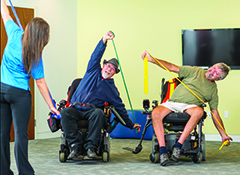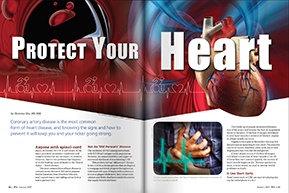Coronary artery disease is the most common form of heart disease, and knowing the signs and how to prevent it will keep you and your ticker going strong
By Christine Zito, RN, BSN
Anyone with spinal-cord injury or disease (SCI/D) is well aware of the many potential secondary conditions and complications that are necessary to monitor. However, there’s one problem that happens to be the leading cause of death in the United States — heart disease.
The most common form of heart disease is coronary artery disease (CAD) and in preparation for American Heart Month in February, now’s a good time to start taking a closer look at how to prevent CAD.
Not An ‘Old Person’s’ Disease
The incidence of CAD among individuals with SCI/D isn’t unique to this population. However, decreased mobility can trigger an increased likelihood of exacerbating CAD.
This problem isn’t an “old person’s” disease. In fact, CAD is a chronic process that can begin at a young age and slowly progress throughout an individual’s life span. It begins with a substance known as plaque (cholesterol, fatty compounds, calcium and fibrin) that forms inside the arteries that supply blood to the heart.
This build-up of plaque increases inflammation of the artery and lessens the flow of oxygenated blood to the heart. If the flow of oxygen-rich blood to your heart muscle is reduced or blocked, angina or a heart attack can occur.
Angina is chest pain or discomfort that may feel like pressure or squeezing in your chest. The pain also can occur in your shoulders, arms, neck, jaw or back. Angina pain may even feel like indigestion.
A heart attack occurs if the flow of oxygen-rich blood to a section of heart muscle is cut off. If blood flow isn’t restored quickly, the section of heart muscle begins to die. Without quick treatment, a heart attack can lead to serious health problems or death.

It Can Start Early
Heart issues such as CAD can start developing during the initial phase of a SCI.
Initially following a SCI, a transient state of loss of all neurological activity (motor, sensory, reflex and autonomic function) takes place, also known as spinal shock. During this phase, individuals experience lower than normal blood pressure, lower than normal heart rate in tetraplegics and higher than normal heart rate in paraplegics.
This early transient state poses great risk for the development of cardiovascular complications such as blood clots and abnormal heart rhythms. Close monitoring by trained clinicians located within an SCI/D center is vital to ensure a strong outcome during this acute phase and into the subacute phase of rehabilitation.
Stay Strong
Optimizing physical fitness levels during acute and subacute rehabilitation is the most important element to maintaining optimal heart health.
For example, increasing sitting tolerance and functional ability in individuals with SCI/D during subacute rehabilitation has the potential to stop cardiovascular deterioration that results from prolonged immobility. Therefore, meeting optimal fitness levels during the acute rehabilitation phase is crucial to reaching and maintaining cardiovascular fitness, as well as functions of daily living in the subacute phase of rehabilitation.
Exercise options vary based on the individual’s level of function as well as the body’s physiological response to exercise. Arm ergometry may be an effective means of improving central cardiovascular fitness in individuals with sufficient arm function but doesn’t reverse peripheral vascular deficits that accompany SCI/D.
Likewise, functional electrical stimulation (FES) is effective in improving cardiovascular health. However, FES may not be tolerated well because of associated risk of pain, skin irritation and autonomic dysreflexia.
The interdisciplinary team at the SCI/D center is a vital in developing exercise treatment plans in collaboration with the patient and their caregiver/family members.
A Long History
The dangers of CAD aren’t new. Despite the challenge of pinpointing the exact discovery of CAD, there is documented discussion dating back to the 15th century.
The great Leonardo da Vinci investigated coronary arteries; William Harvey, physician to King Charles I, discovered the pathway of blood flow from the heart, lungs, aorta, peripheral vessels and back into the lungs.
In the early 1700s, Friedrich Hoffmann, chief professor of cardiology at the University of Halle in Germany, claimed that coronary heart disease began as “reduced passage of the blood within the coronary arteries.” Nearly two centuries later in 1912, James Herrick, an American cardiologist, invented the term “heart attack.”
Learning about the history of CAD has helped health care providers focus on prevention and early detection as a means to improve individuals’ quality of life and longevity.
Making Healthy Changes
One of the best means of prevention and treatment for CAD is healthy lifestyle changes.
Among the changes that improve the cardiovascular system include smoking cessation, exercise and weight control. Furthermore, having a comprehensive annual evaluation at your SCI/D center, including a check of your blood pressure, heart rate and bloodwork, is a critical function for health promotion, prevention, early identification and treatment of CAD.
In fact, in those with tetraplegia, signs and symptoms such as chest pain may be subtle or absent because of sensory impairment. This warrants a 12-lead electrocardiogram to be obtained yearly for all individuals age 35 and older.
A family history of CAD, smoking, sedentary lifestyle, obesity, hypertension and hyperlipidemia are risk factors that can accelerate this chronic inflammatory process.
Because of advances in medical technology, those with SCI/D are living longer and are subject to some of the same multiple medical conditions and diseases able-bodied individuals experience. Therefore, people with SCI/D greater than 30 years old or anyone older than 60 must be monitored by their primary care physician as a means to identify and treat CAD at an early stage.
Start Now
If you fall into any of the risk categories mentioned in this article or you’ve not been checked for CAD, now is the time to act.
Contact your SCI/D center or primary care physician, and ask to schedule a comprehensive preventative health evaluation. Your health is important. Early detection and preventative measures to fight CAD are one evaluation away.

